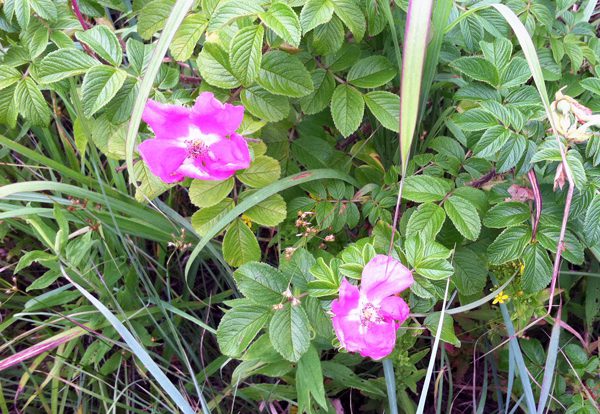A rose by any other name

I’m not immune to the charms of a dozen roses on Valentine’s Day – or any day for that matter – though I’m always disheartened by those with no discernible fragrance and perfect buds that inexplicably shrivel and droop. These are not attributes one cares to associate with romance. I try to limit my purchase of roses to those certified as “fair trade.” These come from growers who agree to meet certain environmental and labor standards. That helps in some regards, but most commercial growers are in Central America, so even “green” roses contribute to my carbon footprint.
As with vegetables, it’s best to grow your own, but that can be a challenge with persnickety hybrid teas. Our still and sultry summer nights make them especially susceptible to fungal diseases such as black spot, rust and powdery mildew, as well as pests such as aphids, thrips and Japanese beetles. When we lived in Raleigh, I often walked past a picture-perfect rose garden in the side yard of an estate in Hayes Barton. I had images of a genteel matron in a wide-brimmed hat and supple pink gloves gathering a wicker basket full of budding roses and displaying them in heavy crystal vases throughout her stately house. This alluring vision was shattered the day I watched a man in rubber boots and protective coveralls unfurl a hose from a tanker truck of chemicals and envelope the garden in a toxic fog.
Trying to be a responsible steward of the earth doesn’t mean we have to give up on roses entirely. If we choose wisely, we can have roses that don’t demand a steady diet of chemical soup. For me, climbers have been a smashing success. My husband gave me a red one for Valentine’s Day many years ago. I planted it on the south side of my grandparents’ farmhouse, and it produces large and fragrant blossoms throughout the growing season despite an appalling lack of attention. I wish I could remember its name. The Lady Banks (Rosa banksiae) is an even more vigorous climber. It covered a 20-foot section of fence at my garden in Charlotte. A prolific bloomer, it produces clusters of soft yellow flowers in late April. The flush comes and goes in a matter of weeks, but that wouldn’t deter me from also trying the white variety. I also grew a delicate climber. “Nastarana” can be maintained as a shrub with a little pruning. Its pale pink buds open to clusters of small, white flowers. Tiny but mighty, they have a heavenly scent. J.C. Raulston, former director of the arboretum at N.C. State that now bears his name, once called “Nastarana” “the best rose in the garden.” I bought mine from Niche Gardens in Chapel Hill. Generally known for their vast selection of native plants, they also take pride in offering roses that aren’t “hooked on fungicides” for their survival.
There are a number of shrub roses that perform well in the Piedmont, including “Chuckles,” a deep pink rose that also appears on the list of lower maintenance roses compiled by University of Georgia plantsman Michael Dirr. He also recommends several roses in the Meidiland series introduced by Conard-Pyle. Rugosas (Rosa rugoa) are probably the hardiest type of shrub rose. Dirr calls the rugosa “a valuable plant for difficult sites: banks, cuts, fills, sandy soils and saline environments.” No wonder they’ve become so popular in recent years.
Most roses in cultivation originated in Asia or the Middle East, but I recently learned we have roses native to the Southeast, making them especially well-adapted to our conditions. The swamp rose (Rosa palustris) was planted in our streamside buffers during our riparian restoration project. This species thrives in damp or boggy sites across the state. Their somewhat lurid fuchsia blooms remind me of a rugosa that hasn’t been tamed. A similar species, the Carolina rose (Rosa carolina) is found in dry, open hardwood forests of the mountains and Piedmont. Unlike the hybrid teas, this species can tolerate quite a bit of shade.
Don’t confuse these native roses with another species we see growing in the wild all too often, the multiflora rose (Rosa multiflora). This rambler is a charming rogue. Once planted as a living fence for livestock, this invasive species now overtakes our native vegetation.
Lovely blossoms aren’t the only reason to grow an assortment of roses. The hips are decorative and nutritious. They’re a common ingredient in herbal teas such as Red Zinger, providing a boost of Vitamin C and other anti-oxidants. My English mother-in-law, the product of a country infatuated with roses, covets them for making a delicious jelly. That said, there’s no shame in simply leaving rose hips on the plant. There, they serve as an important source of food for many wildlife species, including our beloved bobwhite quail.